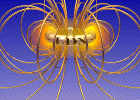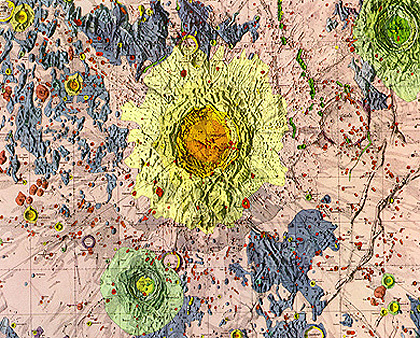|
The Cosmic Conspiracy Part Two |
||
| Mining Connection #001
Titanium - Iron - Ilmenite A sample obtained from the Mare Tranquillitatis lunar region by Apollo 11 astronauts "Buzz" Aldrin and Neil Armstrong. This basaltic lava sample is high in iron and titanium. (Source) A sample collected from the Oceanus Procellarum mare region by Apollo 12 astronauts. Studies conducted on this sample (5) indicate that this is a low titanium, medium grained, olivine basalt that possesses an exceptionally high magnesium content. Large pyroxene oikocrysts surround numerous rounded olivine crystallites, and patches of glomerophric olivine are present in some areas. The sample is composed primarily of the minerals olivine, plagioclase and pyroxene with a trace amount of opaque material. Chemically, the rock is about 42% silicon dioxide, 22% ferrous oxide, with the rest being mainly magnesium, calcium, and aluminum oxides (2). (Source) Limonite - Chemical Formula: FeTiO3, Iron Titanium Oxide. In the processing of this ore free oxygen that can be used for breathing and rocket fuel manufacture is released as a byproduct. The ore yields iron and titanium (Source) Iron - in the form Ferrous Oxide - yields Iron and releases free oxygen. (Source) Glass - Quartz - Silicon Dioxide
LUNAR AND MARTIAN FIBERGLASS AS A VERSATILE FAMILY
OF ISRU VALUE ADDED PRODUCTS
Water - H20
The initial estimate of the amount, to be determined more accurately with later observations, is 30 to 300 million metric tons (recent thinking has raised the upper limit to perhaps as high as 3 billion tons). If melted, this larger number would fill a "lake" 10 square kilometers in area (3.1 x 3.1 km) to a depth of 10 meters. (Source) Zinc The orange soil was brought back from the Taurus-Littrow landing site by the Apollo 17 crewmen. Scientist/Astronaut Harrison H. Schmitt discovered the orange soil at Shorty Crater. Like those samples, it is rich in titanium (8%) and iron oxide (22%). But unlike the Apollo 11 samples, the orange soil is unexplainably rich in zinc. (Source) Note. Gravity Shielding Experiments at Los Alamos National Laboratory Using ZnS A Gravitational Shielding Based upon ZnS: Ag Phosphor - by R. C. Woods 0204031 Note: ISRU means In Situ Resource Utilization, in other words what is on the Moon stays on he Moon. Mining operations to support a Base or Colony on he Moon would require materials for construction Etc. Most of the mining, colonization, and base construction plans at LPI talk in terms of ISRU, NOT returning the minerals to Earth. Many people following our mining on the moon theory argue that it would be too costly and to difficult to transport to Earth. Seems they don't intend to. That brings up Helium 3. Any operations on the Moon and Mars plus transport to and from would require a good source of power. Helium 3 is that source... clean, relatively safe and in abundance on the moon. While 25 tons could supply the entire US power needs for one year, this too will most likely be ISRU, making new Helium Barons on the Moon... Helium 3 - HE3 In their 1988 paper, Kulcinski, et al. (see ref note below), estimate a total of 1,100,000 metric tonnes of He3 have been deposited by the solar wind in the lunar regolith. Since the regolith has been stirred up by collisions with meteorites, we'll probably find He3 down to depths of several meters. That amount of He3 would produce approximately 20,000 terra watt years of thermal energy, about 10 times the amount if we burned all the fossil fuels on Earth. without the pollution. Another way to state it, 25 tons would power the United States for 1 year, which is about the maximum size of the payload of a Space Shuttle (Source) How can they use the Helium 3?
A "Wheel within a wheel..." Levitated Dipole Fusion Confinement Concept - MIT Plasma Science & Fusion Center Thorium Thorium as a nuclear fuel Thorium, as well as uranium and plutonium, can be used as fuel in a nuclear reactor. Although not fissile itself, 232Th will absorb slow neutrons to produce uranium 233 (233U), which is fissile. Hence, like 238U, it is fertile. In one significant respect 233U is better than the other two fissile isotopes used for nuclear fuel, 235U and plutonium 239 (239Pu), because of its higher neutron yield per neutron absorbed. - Source - Wikipedia The interesting thing is that
the majority of these valuable Minerals are found in the heaviest concentrations
around Copernicus Crater. The data was collected by non other than our
Friend Clementine
|
||
|
Mining Connection #002 Three people!!! However, a loophole in Space Law allows individuals and companies to hold Mineral Rights on the Moon, Mars and other celestial bodies. Growing concern from Scientists that these rights may be held hostage have been alleviated by a three man North American team; Dr. Joseph Resnick, Dr. Timothy R. O'Neill and Guy Cramer (ROC-Resnick/O'Neill/Cramer team) who have acquired the mineral rights for 95% of the side of the moon that faces Earth, the polar regions and 50% of the far side of the moon. - Source Dr. Resnick found the loophole
in Space Law 25 years ago that allowed him ownership of all planetary bodies
outside the "Third Planet from the Sun"... submitted this to the World
Court at the Hague, and to the United Nations in New York City. In 25+
years no one has ever disputed Dr. Resnick's claimed ownership. Source
|
||
| Mining Connection #003
In 1960, the USGS established an astrogeology program on behalf of NASA to support lunar and planetary exploration. A prime activity of the program is the systematic mapping of the stratigraphy and structure of the Moon, Mars, Venus, Mercury, and the moons of the outer planets. Many USGS maps of the Moon, Mars, Mercury, Venus, and the moons of Jupiter and Saturn are now available for purchase by the public. These maps are in the Miscellaneous Investigations (I) Series. The maps include geologic, topographic, photo mosaic, and shaded relief maps. The scales, projections, and sheet sizes of these maps vary widely.
Comments:
|
||
| Mining Connection #004
USGS 1967
After some intensive searching
I have found the full scale original USGS Lunar topographical and mining
maps of the Moon. The one specific to Copernicus crater is below {a small
clip reduced in size}. Click on the image below to take you to the source
files. Those of you with dial up be aware that the full scale images are
over 100 megs in size!
Geologic
Atlas of the Moon Listing a pdf file.
Comments:
|
||
| Mining Connection #005
Ancient or Alien Technology Since it is our position that the mining operation on the moon was an exiting operation that we merely took over, it would be logical to assume that there would be technology in place that we have "discovered" and in that case would in effect be "mining for technology". The fact that the moon would preserve anything for a long period of time that isn't left exposed on the surface, could mean that we would find a lot of invaluable equipment and technology from either an Ancient Race or from some Alien Civilization that was here before... More on this coming soon.... |
||
| FAIR USE NOTICE: This page contains copyrighted material the use of which has not been specifically authorized by the copyright owner. Pegasus Research Consortium distributes this material without profit to those who have expressed a prior interest in receiving the included information for research and educational purposes. We believe this constitutes a fair use of any such copyrighted material as provided for in 17 U.S.C § 107. If you wish to use copyrighted material from this site for purposes of your own that go beyond fair use, you must obtain permission from the copyright owner. | ||
|
|




